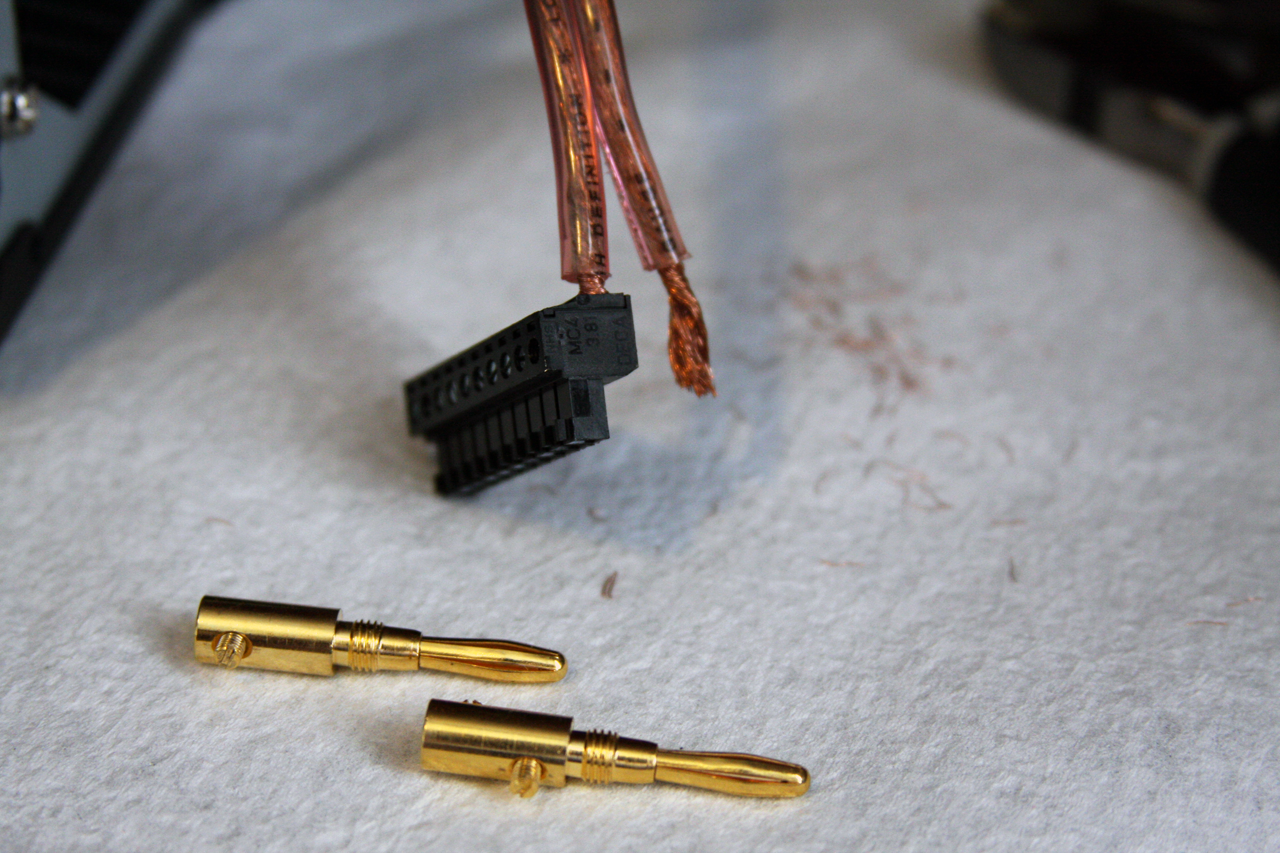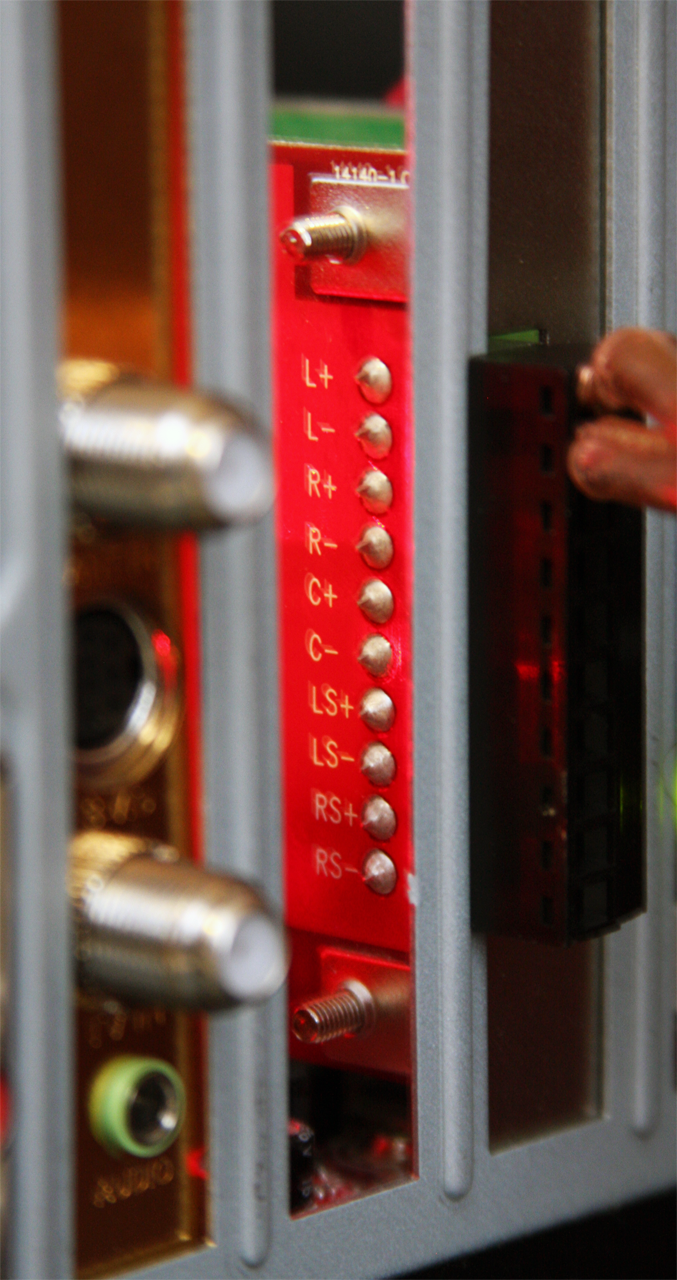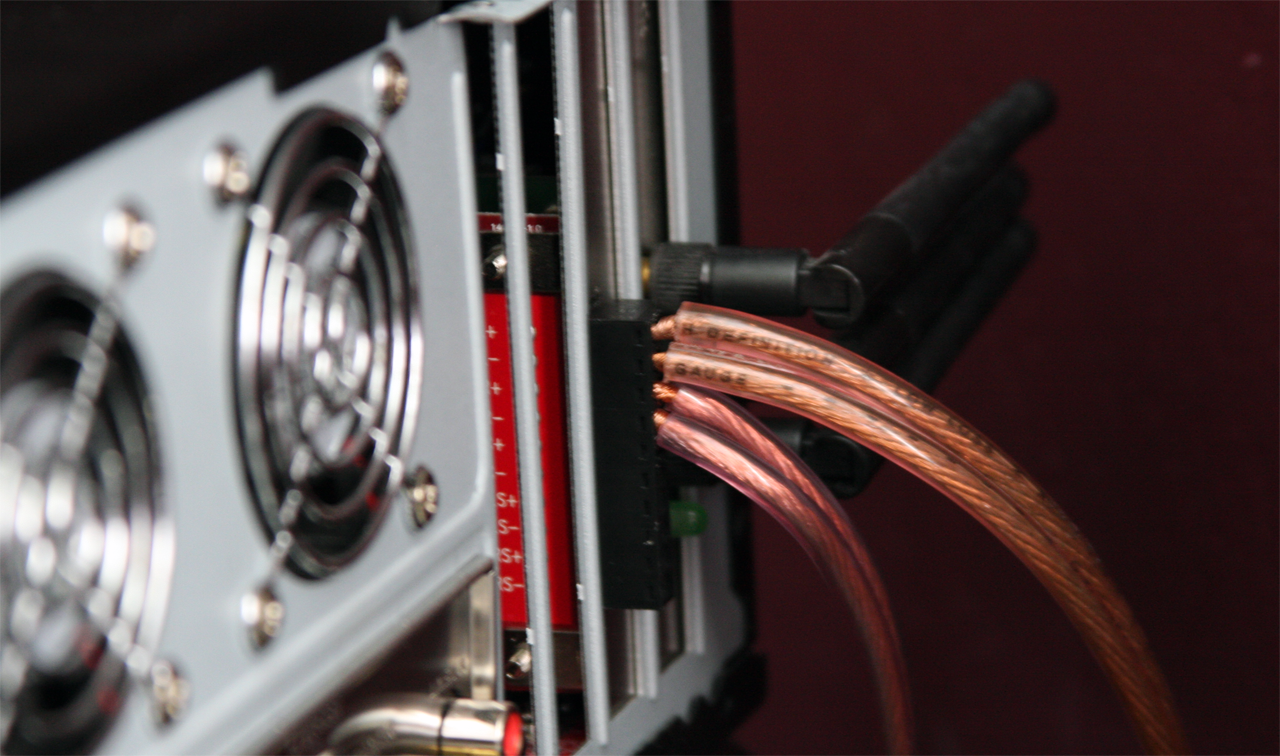The HTPC / Windows 7 Chronicles: You Asked, We Answer!
Amp Up: Give The MSI Five Channel Card A Shot
Jschoorl weighed in with his own positive experiences using the MS-4140 sound card, and indeed, there is an entire 75-page thread on AVS Forum dedicated to using Maui with the onboard D2 chip. I took a lot of heat in the first story for not testing the Maui platform’s amp. After all, as that same AVS Forum thread pointed out, this is the whole point of paying extra for this board is the D2/MS-4140 combination.
Admittedly, this isn’t something I really cared to do—after all, I had a capable receiver in place, and the speaker block on the back of the MS-4140 is, in my opinion, a mess. With no support for banana clips, you’re left clipping the ends of your speaker wire, cramming it into the end of the block, and hoping you’re not using anything larger than 14 gauge wire (maybe 12 gauge). Nevertheless, it was an oversight to think I could build the box up without testing that component as an option and not get some negative feedback as a result.
AMD’s Jay Taylor weighs in here with an observation and a suggestion. First, that high-density speaker block is actually an industry standard, allowing MSI to cram all of that connectivity onto a low-profile card if necessary. It’d take an OEM to design something more elegant at this point. And, for those who want to work around the quasi-nightmare of cabling, it’s completely feasible that you might run wires from the block to a wall-mount speaker bracket, preserving the use of banana clips from your passive speakers and cutting back on the mess.
Laying A Foundation On The DAE-3 Amp
The D2Audio DAE-3 has been lauded over and over for its programmability, flexibility, and quality. But up until now we haven’t seen Intersil really do anything to enable the goodness AMD’s home theater team has evangelized. But it’s a work-in-progress and AMD’s Taylor tells us that the platform is going to soon see its first major update. A little background first, though.
Why is this planned update so significant? Well, to begin, the Media Live Diva motherboard is being offered (with the 5.1-channel amp card) as a substitute for your home stereo receiver, so it really needs to enable functionality similar to what you’d expect from a $300 or $400 consumer electronics component (AMD actually thinks the value is closer to a $700 receiver). “But that’s ludicrous,” you say. “My receiver is a 50-pound beast loaded with huge caps and even larger heatsinks. There’s no way a PCI Express card and an onboard IC are going to match that.”
In fact, you’re actually talking about two different technologies there. Many stereo receivers employ analog Class A or Class AB (most common) amplifiers, which offer various levels of power efficiency versus sound quality, but most often, represent the large, heavy receivers to which you’re accustomed. They amplify the entire analog waveform, and are consequently favored by enthusiasts who claim they deliver warmer, richer sound.
Get Tom's Hardware's best news and in-depth reviews, straight to your inbox.
D2Audio’s DAE-3 is a Class D switching amp that reproduces the audio waveform by sampling it digitally at a very high frequency. Because the technology has advanced far enough, you can get sound quality that rivals some of the best Class AB amps using Class D hardware now—this is what AMD, MSI, and D2Audio are trying to demonstrate here. According to D2Audio, the DAE-3 is 93%+ efficient compared to the typically 50%-ish efficiency of an AB amp. Consequently, less of the power it draws from the wall is dissipated as heat (purportedly about 10W under load), and that’s why it’s able to fit on a PCI Express card. Instead of the massive transformer and capacitors typical of most AB amps, D2Audio’s design uses a switched mode DC-DC converter for its power supply.
Interestingly, the 5.1-channel card with all of the amplification circuitry on it is spec’ed to deliver 5 x 100W of output, which you might find interesting given the 450W Corsair power supply we featured in Part 1 of this exploration. D2Audio makes it a point to emphasize the real-time power supply monitoring that goes on in its DSP. In essence, this feature keeps tabs on input voltages and, if draw from the amplifier appears to be on the verge of inducing a brownout or reset state, it’ll gracefully scale back draw (and output) from the amp until safe conditions are re-established. This is particularly important with a PSU rated for less output than the amp’s potential. However, I didn’t run into any trouble during testing—a testament to the quality of Corsair’s 450W offering.
Current page: Amp Up: Give The MSI Five Channel Card A Shot
Prev Page What’d You Use For A Remote Control? Next Page Amp Up: Using Maui’s Amp, Continued-
WheelsOfConfusion Nice follow-up. A bit more entertaining than benchmarking the same suite of games over and over, I'll bet.Reply
Unfortunately you ran into that DRM breakdown problem, where one snagged link in the hardware/software chain negated the high-quality features we're supposed to be enjoying through "easy" and "transparent" copy protection schemes. DRM will make criminals of us all, one way or another: if not by trying to get around it, then when we go on a bloody rampage out of frustration from trying to make it work. -
mcboj Nice article. Made for a good read, as I'm wanting to build a HTPC very soon. Seems crazy that the combined might of all these manufacturers aren't able to make this work 100% yet. Too many cooks in the kitchen?Reply -
Luscious Great article. I've been looking into getting BD content onto a HTPC but have run into the same DRM and audio issues as you describe. DVD's were a lot easier to deal with, but BD is an entirely different animal. True, I've yet to experiment with Win7 and have only touched Vista and MCE so far. I'm probably going to wait a few more months for Win7 to show before I look into it further.Reply
I do agree in your choice of a dedicated receiver. I've got an Onkyo receiver connected to Yamaha speakers in a 7.1 arrangement that I use primarily as a source switch. Originally I had three DVD changers that I replaced with a HTPC. It's worked well, but now with a growing BD library I need to take a second look at my system. Unlike you, however, I chose to go with a dedicated gaming box alongside with passive PSU, passive GPU and a silent CPU heatsink for big-screen gaming. The multiple HDMI and audio inputs on the receiver helped out big time. I also have a dedicated BD player at the moment that I'll probably keep just in case. -
empstar Hi I'm new to HDTV or HDPC I'm using the laptop(HP media DV1125 C2D, ATI 4650) to connect to my SONY 32" LCD TV 100MHz motion flow (32W550 just bough it on 04july09) using HDMI cable 1920x1024 Max Res. but the picture/win desktop look ugly and the front in the windows exploere lookReply
ugly too. Q1) how to SET? the best res? and Q2) should I use HDMI or PC-input (D-Sub 15 pin) to connect? DVD player connected to watch movie look great. HELP... some one? -
quadrophenia I thought I read somewhere that Maui does not work if you don't have an HD tv. Can anyone confirm this? ThanksReply -
kazius There are a lot of factors that you didn't factor in: room acoustics, speaker quality, speaker placement (NEVER place the speakers directly in the corner - like as seen in the pictures), and so on. These make the audio comparison a moot point - I'd expect a richer low end may actually harm the overall listening experience in such a setup, inaccurate spectral positioning, and a somewhat muffled/smudged sound.Reply
... Of course, nearly everyone makes these mistakes, because even home theater and PC enthusiasts tend to think that like the screen or PC, higher quality components is all you actually need for better results... which is true only after you solve all the acoustic issues in your setup. -
profundido Dear Tom,Reply
I have started my quest for the holy grail of htpc 2 years ago and have found it about a month ago. I set for myself the following requirements:
-it must be 1 box that is able to handle ALL available media
-it must be user friendly and relative dummy proof: no switching audio formats and settings in between movies, just press play and experience the magic (a typical non-tech minded person must be able to play it all)
-it must serve as TV-VCR in it's highest possible quality
-the audio quality must be at high end hifi quality in such a degree that if you play FLAC from it professional hifi dealers are blown away
-video must be full-HD
-it must be able to play current videogames fluent in full-hd res
-it must be able to handle all bluray audioformats flawlessly including dts-hd, master and LPCM WITHOUT HAVING TO SET ANYTHING OR SWITCH ANYTHING in the settings of the htpc
-it must appear and look like a receiver, not like a pc in the living room
-the surround sound must meet THX reference standards and volume
my quest led me through (funny) the exact same products and their respective problems among many others. I was able just like you to get the digital passthrough to work with the Xonar 1.3 deluxe but with that card a few problems remain such as having to switch standards before playing it in the Xonar console, malformed LPCM that sounds flattened and lacking bass etc and last but not least the very slow hdmi-video switching of all Onkyo receivers so that wasn't perfect. Then I went to a hi end hifi seminar and listened to the professional audiocard of Onkyo and was totally blown away by the amazing crystal clear sound quality it produces in combination with a proper receiver that amplifies the channels seperately in a fully analogue way. That's when the light hit me. I rebuilt my entire htpc concept around this "analogue" setup and left the trail of the "immature hdmi" path. The result was amazing. 1 time calibration with the aid of Vista Ultimate built-in room correction and I was in the middle of the best htpc experience I had ever witnessed. I'm so happy with the result since it meets all the criteria of the holy grail. I also store and stream bluray content in full size on a 6.5TB windows drive at the speed of full gigabit (RAID 8*1TB) and play it with Arcsoft TMT 3. High dev TV functionality is provided with Firedtv, an austrian solution that allows digital satellite HD streams to be displayed directly on the pc with a modified version of DVB viewer as software (more userfriendly). For the analog amplification And all that in a fusion remote case from Antec é voila, there's your holy grail in a slim slick box ;) -
profundido correction of missing part in above reply: For the analogue amplification of all 7.1 channels at THX ultraplus 2 standards and the volume of dolby reference I use the Onkyo 906 networkreceiver with 200watt per channel. Once the setup is calibrated, nothing else has to be done or switched on the receiver except volume control.Reply -
swt_2k Great information in this article "The HTPC / Windows 7 Chronicles: You Asked, We Answer!”Reply
Like most Media Center software users, I wanting to see a Digital PCI tuner card certify by Cablelabs; I don’t like to set top cable box. By-the-way, you cannot find the "ATI TV Wonder Digital Cable Tuner" anywhere. Sony no long lists that item. Also that item only uses the 1.0 unidirectional cable cards as opposed to the new 2.0 bi directional cable cards. Cablelabs is too slow bringing a digital cable card solution to the market.
Does any know when or where I can buy a digital tuner like the ones in current LCD TVs?
-
Shadow703793 Not sure if this was out when this was written, but there are PASSIVELY cooled 4670s. For example: http://www.newegg.com/Product/Product.aspx?Item=N82E16814102816Reply



